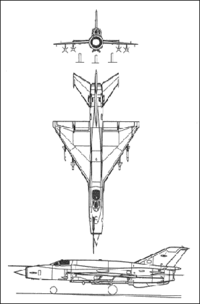Mikoyan-Gurevich MiG-21
|
|
| Mikoyan-Gurevich MiG-21 | ||
|---|---|---|
 A MiG-21 Lancer at Farnborough 2002 | ||
| Description | ||
| Role | Light interceptor | |
| Crew | 1 | |
| First Flight | 14 June 1956 | |
| Entered Service | 1959 | |
| Manufacturer | MIG MAPO, Russia | |
| Dimensions | ||
| Length | 15.76 m | 51 ft 8 in |
| Wingspan | 7.15 m | 23 ft 5 in |
| Height | 4.12 m | 13 ft 6 in |
| Wing area | m² | ft² |
| Weights | ||
| Empty | 5350 kg | 11,800 lb |
| Loaded | kg | lb |
| Maximum takeoff | 9660 kg | 21,300 lb |
| Powerplant | ||
| Engines | One Tumanskii R-25-300 turbojet | |
| Thrust | 7,100 kgf 70 kN | 15,700 lbf |
| Performance | ||
| Maximum speed | 2230 km/h | 1385 mph |
| Combat range | 450-500 km | 280-310 mi |
| Ferry range | km | mi |
| Service ceiling | 19,000 m | 62,300 ft |
| Rate of climb | 120 m/s | 23,600 ft/min |
| Wing loading | kg/m² | lb/ft² |
| Thrust/Weight | ||
| Avionics | ||
| Avionics | ||
| Armament | ||
| Guns | One centreline twin-barrelled GSh-23 23 mm cannon or one single-barrelled NR-30 cannon | |
| Ordnance | 2000 kg (4400 lb) on four underwing hardpoints | |
Mikoyan-Gurevich MiG-21 (NATO reporting name Fishbed) is a fighter aircraft, originally built by the Mikoyan and Gurevich Design Bureau in the Soviet Union. It is the most common post-World War II military aircraft, with the exception of the Lockheed C-130 Hercules.
The first delta-wing prototype (named Ye-4, written also E-4) flew in 14 June 1956, and the production Mig-21 entered service in early 1959.
The MiG-21 saw frequent action in the Vietnam War and was one of the most advanced aircraft at the time. However, many North Vietnamese aces preferred flying the MiG-19, due to the wingload on the MiG-21's wings. Employing a delta wing configuration, it was the first successful Soviet aircraft combining fighter and interceptor in a single aircraft. It was a lightweight fighter, achieving Mach 2 speed using a relatively low-powered afterburning turbojet, and is thus comparable to the American F-104 Starfighter and French Dassault Mirage III.
It was also used extensively in Middle East conflicts of the 1960s and 1970s, by the air forces of Egypt, Syria and Iraq against Israel. The plane was completely outclassed by the much more modern F-15 Eagle, which was acquired by Israel in the 1970's.
It was used also in early stages of the wars in Afghanistan but soon outclassed by the newer MiG-23 and MiG-27.
Versions
- E-4 - first prototype
- MiG-21 - first series of fighters
- MiG-21F (prototype E-6T)
- E-66 - record breaking version
- MiG-21F-13 - export version (type 74)
- MiG-21PF - (prototype E-7, type 76)
- MiG-21FL - (type 77)
- MiG-21SPS - (East German version)
- MiG-21PFM
- MiG-21S - (incorrectly identified by NATO as MiG-21PFMA; E-8, type 88)
- MiG-21PFV - (North Vietnam version)
- MiG-21M - (version with R-13 engine)
- MiG-21MF - (version with R-13 engine)
- MiG-21SMT - (E-9, block 94 and 96) (version with R-13 engine)
- MiG-21bis - (version with R-25 engine)
- MiG-21U - two seater version (type 66), NATO reporting name "Mongol"
- MiG-21US - two seater version (type 68)
- MiG-21UM - two seater version (type 69)
- MiG-21-93 - (also the Bison)
Foreign versions
The production of MiG-21s (bis variant) under license by HAL of India lasted till 1984. Despite a series of crashes over the last decade, and acquiring the nickname "flying coffin", the Indian Air Force has decided to upgrade about 125+50 of the Mig-21bis in its inventory to the Mig-21 Bison standards which will serve the Indian Air Force till the year 2015.
Unlicensed Chinese copies of the MiG-21 are designated Chengdu J-7 and F-7 (for export).
Russia now offers an upgrade pack for the MiG-21 to MiG-21-93 standard. This includes an avionics suit upgrade including the installation of the Kopyo pulse doppler radar used by the advanced MiG-29, enabling the aircraft to fire a greater range of advanced weapons such as the advanced beyond visual range R-77 Vympel air-to-air missile. The upgraded avionics also enhanced the aircraft survivalbility in battles as well as its ability to engage enemy fighters. Other upgrades include the installation of a dual screen HUD, helmet-mounted target disignator, and advanced flight control systems.
Israeli Aircraft Industries manufactures an upgrade package for Mig 21 called the MiG-21-2000.
A joint venture between Aerostar SA and Elbit have developed the Lancer upgrade pacakge for Mig 21. 102 Mig 21s have been upgraded to Mig 21 Lancer for the Romanian Air Force.
| Related content | |
|---|---|
| Related Development | |
| Similar Aircraft | |
| Designation Series |
MiG-15 - MiG-17 - MiG-19 - MiG-21 - MiG-23 - MiG-25 - MiG-27 |
| Related Lists | List of military aircraft of the Soviet Union and the CIS - List of fighter aircraft |
|
Lists of Aircraft | Aircraft manufacturers | Aircraft engines | Aircraft engine manufacturers Airports | Airlines | Air forces | Aircraft weapons | Missiles | Timeline of aviation |
de:Mikojan-Gurewitsch MiG-21 fr:Mikoyan-Gurevitch MiG-21 he:מיג 21 id:MiG-21 ja:MiG-21 (戦闘機) pl:MiG-21 sv:MiG-21

